
Aralia spinosa, commonly known as devil's walking stick, is a woody species of plant in the genus Aralia, family Araliaceae, native to eastern North America. The various names refer to the viciously sharp, spiny stems, petioles, and even leaf midribs. It has also been known as Angelica-tree.

Yucca elata is a perennial plant, with common names that include soaptree, soaptree yucca, soapweed, and palmella. It is native to southwestern North America, in the Sonoran Desert and Chihuahuan Desert in the United States, southern Nevada, southwestern Utah, and northern Mexico. Yucca elata is widely distributed, although its population appears to be decreasing.

Stephanomeria is a genus of North American plants also known as wirelettuce, belonging to the tribe Cichorieae within the family Asteraceae.
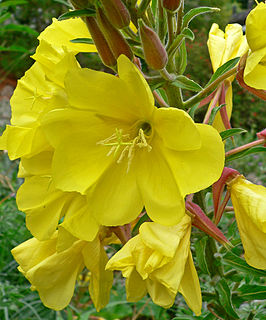
Oenothera elata is a species of Oenothera known by the common name Hooker's evening primrose or tall evening primrose. Subspecies include hookeri, hirsutissima, longisima, jamesii, villosa and elata. It is native to much of western and central North America. The plants are quite tall, especially the hookeri subspecies, native to California, which can reach about 1.8 meters height. The plants are found along roadsides, in moist meadows, or woodland, from sea level up to 9,000 ft (2,700 m) in elevation.
Munzothamnus is a monotypic genus of flowering plants in the family Asteraceae containing the single species Munzothamnus blairii, which is known by the common name Blair's wirelettuce, or Blair's munzothamnus. It is endemic to San Clemente Island, one of the Channel Islands of California. It grows along steep, rocky cliffsides and canyons on the island. It is a shrub producing a fleshy, woolly stem usually over a meter in height, often approaching two meters. Leaves occur in tufts at the ends of the stem branches. They are up to 15 centimeters long, oblong in shape, and sometimes very shallowly lobed. They are woolly when new but lose their hairs and become shiny green with age. The inflorescence is a large array of up to 35 flower heads. Each head has a cylindrical base under a centimetre long and contains 9 to 12 light lavender or pinkish flowers. Each flower is a ray floret with an erect tube and a strap-shaped ligule with a toothed tip. The ligule is just under a centimetre long. The fruit is a cylindrical, ribbed achene with a white pappus.
Prenanthella is a monotypic genus of flowering plants in the family Asteraceae. It contains the single species Prenanthella exigua, which is known by the common name brightwhite. It is native to the southwestern United States from California to Texas and it is known as far north as Idaho. Its habitat includes desert and woodlands. This annual herb produces a slender, branching stem reaching a maximum height near 40 centimeters. It has a sparse coating of glandular hairs and contains a milky juice. Most of the leaves are located near the base of the stem. They are widely lance-shaped and sometimes divided into segments. Smaller leaves occur higher on the stem; these may be reduced to scale-like structures, leaving the stem mostly bare. The inflorescence is a wide open panicle of several flower heads. Each small head is cylindrical and narrow, its base wrapped in lance-shaped phyllaries. At the tip of the head bloom 3 or 4 flowers, which are ray florets; there are no disc florets. Each floret has is white to pale pink and has a toothed tip. The fruit is a white achene with a pappus of white bristles.

Stephanomeria malheurensis, the Malheur wirelettuce, is a species of flowering plant in the family Asteraceae. It is endemic to Oregon in the United States. It is a federally listed endangered species.

Stephanomeria exigua, the small wirelettuce, is a perennial or biennial plant native to the western United States. It is thought to be the parent species of Stephanomeria malheurensis, an endangered plant species found only in southern Oregon. It generally blooms from mid-spring to late summer and produces small, light pink or light purple blooms.

Stephanomeria virgata, commonly called rod wirelettuce, twiggy wreath plant, and virgate wirelettuce, is a herbaceous annual plant of the family Asteraceae. It can be found growing in Western North America, specifically California, but also in Oregon and Nevada and northern Mexico. This plant can be found in dry, open habitat types at elevations below 2100 meters. S. virgata is sometimes used as an ornamental plant.
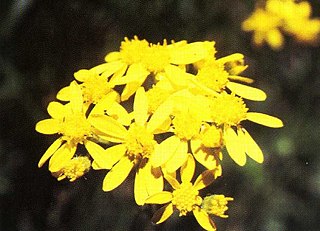
Senecio hydrophilus is a species of flowering plant in the aster family known by the common names water ragwort and alkali-marsh ragwort. It is native to western North America from British Columbia to California to Colorado, where it grows in swampy places such as marshes. It can grow in standing water, including alkaline and salty water. It is a biennial or perennial herb producing a single erect stem or a cluster of a few stems which may exceed one meter in maximum height, at times approaching two meters. The stem is hollow, waxy in texture, and often pale green in color, and it emerges from a small caudex. The thick leaves are lance-shaped to oval with smooth or toothed edges, the blades up to 20 centimeters long and borne on petioles. Smaller leaves occur farther up the stem. The inflorescence is one or more large, spreading clusters of many flower heads. They contain many yellowish disc florets at the center and sometimes have small yellow ray florets as well.

Spergularia macrotheca is a species of flowering plant in the family Caryophyllaceae known by the common name sticky sandspurry. It is native to western North America from British Columbia to Baja California, where it grows in many types of moist coastal and inland habitat, often in alkaline and saline substrates. It may be found in marshes, alkali flats, beaches, meadows, seeps, and vernal pools. It is a perennial herb producing a narrow stem up to 40 centimeters long with a woody, thickened base and taproot. They may grow erect or prostrate across the ground. It is covered in sticky glandular hairs, especially in the inflorescence. The stems are lined with fleshy linear leaves, sometimes tipped with spines. The leaves are accompanied by triangular stipules up to a centimeter long each. Flowers occur in clusters at the end of the stem as well as in leaf axils. The small flowers have five pointed sepals and five oval white to lavender-pink petals. The fruit is a capsule containing tiny reddish brown, winged seeds.
Stanleya elata is a species of flowering plant in the family Brassicaceae known by the common name Panamint princesplume. It is native to the desert mountains of eastern California and western Nevada, where it grows in rocky and scrubby habitat types. It may also occur in Arizona. It is a perennial herb producing one or more erect stems reaching about 1.5 meters in maximum height. They are hairless and often waxy in texture. The thick, leathery leaves have lance-shaped or oblong blades with smooth or toothed edges measuring up to 15 centimeters long. They are borne on petioles. The top of the stem is occupied by a long inflorescence which is a dense, snaking raceme of many flowers. Each flower has four narrow, threadlike yellow or whitish petals each about a centimeter long and a millimeter wide. The fruit is a long, thin, wormlike silique which may be 10 centimeters in length. It contains tiny seeds.
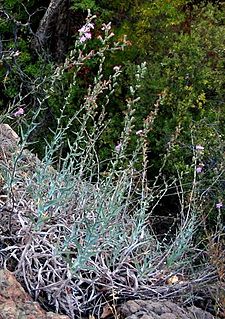
Stephanomeria cichoriacea is a species of flowering plant in the family Asteraceae; it is known by the common names chicoryleaf wirelettuce and silver rock-lettuce. It is endemic to California, where it grows in the coastal mountain ranges as far north as Monterey County, but especially in southern California mountains such as the Transverse Ranges. Its habitat includes chaparral. It is a perennial herb producing slender erect stems reaching maximum heights exceeding one meter. The stem is woolly with hairs, especially on new growth. The leaves are mostly located in a basal rosette, the largest reaching 18 to 20 centimeters long. They are lance-shaped and often toothed along the edges, and the newer ones are woolly. Smaller leaves occur farther up the stem. The inflorescence is a long array of several flower heads, with some occurring in the upper leaf axils as well. Each head has a cylindrical base 1 to 2 centimeters long which is lined with layers of glandular phyllaries. The head contains 10 to 15 ray florets, each with an elongated tube and a pink ligule which may be up to 2 centimeters long. The fruit is an achene tipped with a spreading cluster of long, plumelike pappus bristles.
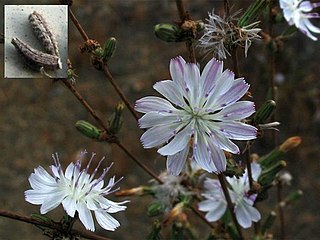
Stephanomeria diegensis is a species of flowering plant in the family Asteraceae known by the common name San Diego wirelettuce. It is native to the coastal hills and ranges of southern California and Baja California, where it grows in many types of open habitat. It evolved as a hybrid of Stephanomeria exigua and S. virgata. Furthermore, it is thought to be the result of homoploid hybrid speciation, which is uncommon. The plant is frequently misidentified as one of its parents, especially if older taxonomic keys are used. This is an erect annual herb easily exceeding two meters in height. Its slender stem has many spreading branches. The basal leaves are linear to lance-shaped and up to 10 centimeters long. The leaves wither early and are absent for most of the year, giving the plant a twiglike appearance. Leaves on the upper stem are small and reduced. The inflorescences are usually clusters of flower heads located at intervals on the stiff branches. Each head has a cylindrical base lined with phyllaries. These are often glandular. The head contains several ray florets, each with an elongated tube and a white or pink-tinged ligule measuring around a centimeter long. The fruit is a grooved achene tipped with a spreading cluster of long, plumelike pappus bristles.

Stephanomeria lactucina is a species of flowering plant in the family Asteraceae known by the common names lettuce wirelettuce and woodland wirelettuce. It is native to Oregon and California, where it grows in coastal and inland mountain ranges, including the Sierra Nevada. It can be found in many types of habitat, including coniferous forests. It is rhizomatous perennial herb producing a slender, erect stem reaching 30 to 60 centimeters in maximum height. The linear or lance-shaped leaves are up to 8 centimeters long and their edges are lined with widely spaced teeth. Solitary flower heads occur on erect peduncles. Each head contains up to 10 ray florets, each with an elongated tube and a fringed pink ligule roughly a centimeter long. The fruit is an achene tipped with a spreading cluster of long, plumelike pappus bristles.
Stephanomeria paniculata is a species of flowering plant in the family Asteraceae known by the common names tufted wirelettuce and stiff-branched wirelettuce. It is native to the northwestern United States, where it grows in many types of habitat, including disturbed areas. It is an annual or biennial herb producing a slender, erect stem with stiff, widely spreading branches toward the top. It is hairless. The leaves are mostly located in a basal rosette, the largest reaching 10 centimeters long. Smaller, linear leaves occur along the upper stem. Flower heads occur singly or in small clusters along the stiff branches. Each head contains 4 to 6 ray florets, each with an elongated tube and a pinkish or lavender ligule up to 1.4 centimeters long. The fruit is an achene tipped with a spreading cluster of long, white pappus bristles.
Stephanomeria parryi is a species of flowering plant in the family Asteraceae known by the common name Parry's wirelettuce. It is native to the southwestern United States, where it grows in many types of habitat, including many desert areas. It is a perennial herb growing from a thick root and producing one or more slender, upright stems up to about 40 centimeters tall. The green leaves are linear to lance-shaped with lobed edges and are up to 8 centimeters long near the base of the plant. Flower heads occur on the spreading branches. Each has up to 13 or 14 ray florets, each with an elongated tube and a whitish ligule up to 1.5 centimeters long. The fruit is an achene tipped with a spreading cluster of long, tan, plumelike pappus bristles.

Stephanomeria pauciflora is a species of flowering plant in the aster family known by the common names brownplume wirelettuce, few-flowered wirelettuce, and prairie skeletonplant. It is native to the southwestern United States and northern Mexico, where it grows in many types of habitat, including many desert areas, woodlands, and plains. It is a perennial herb or bushy subshrub producing one or more sturdy, stiff stems with many spreading branches, taking a rounded but vertical form. The leaves are mostly basal and ephemeral, with smaller, scale-like leaves occurring on the upper stem. Flower heads occur at intervals along the mostly naked stems, especially near the tips. Each has a cylindrical base covered in hairless phyllaries. It contains 3 to 6 florets, each with an elongated tube and a flat pink ligule. The fruit is an achene tipped with a spreading cluster of plumelike pappus bristles. These are usually brownish, but are sometimes white. The specific epithet pauciflora, refers to the Latin term for 'few flowered'.
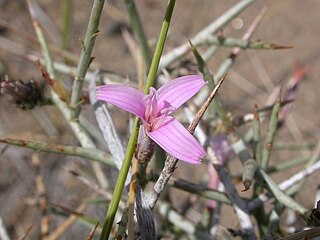
Pleiacanthus is a monotypic genus of flowering plants in the family Asteraceae containing the single species Pleiacanthus spinosus, which is known by the common name thorn skeletonweed, or thorny skeletonweed. It is native to the western United States from Montana and Idaho to southern California and Arizona, where it grows in many types of mostly dry habitat from deserts to mountains. It is a spindly subshrub producing several slender stems up to 40 or 50 centimeters tall from a woody caudex. The stems divide many times into short, rigid branches which narrow to sharp thorn-tips. The plant is mostly hairless except for brownish woolly tufts at the base and below the basal leaves. The leaves are small and linear on the lower stem, and reduced to scale-like growths on the upper branches. Flower heads occur near the ends of the branches. Each has a cylindrical base wrapped in one layer of phyllaries. The head contains 3 to 5 ray florets, each with an elongated tube and a pale to bright pink ligule. The fruit is an achene tipped with a cluster of pappus bristles which are not plumelike as are those of the Stephanomeria species with which this plant was once classified.

Actaea elata is a species of flowering plant in the buttercup family known by the common name tall bugbane. It is native to the Pacific Northwest of North America, where it can be found in British Columbia, Washington, and Oregon.













